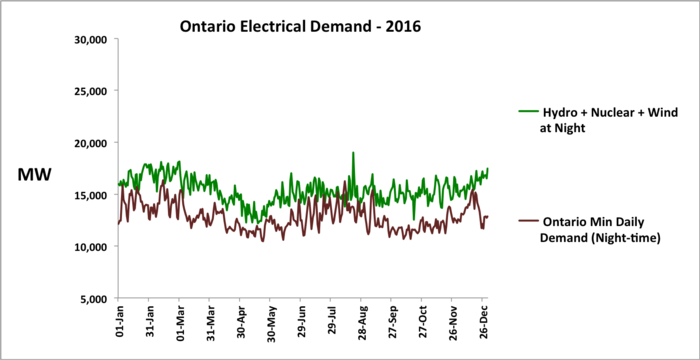
Source: OSPE Energy Task Force, April 2017.
| Home | Energy | Nuclear | Electricity | Climate Change | Lighting Control | Contacts | Links |
|---|
DEFINITIONS:
Clean Electricity is electricity that is generated without emission of fossil CO2.
Dependable Electric Power is the electric power drawn by loads that need electricity which is almost always available.
Interruptible Electric Power is the total available clean electric power less the Dependable Electric Power.
Annual Interruptible Electric Energy Supply is the time integral of the Interruptible Electric Power over one year.
ORIGIN OF INTERRUPTIBLE ELECTRICITY:
Climate change is forcing mankind to obtain energy from clean electricity sources rather than from combustion of fossil fuels. However, the amount of power available from clean electricity sources is a complex function of time that is unrelated to the grid load profile imposed by consumers who need dependable electricity. In order to have a functional clean electricity system the available clean electricity generation must always exceed by a reserve margin the dependable electricity load. The amount by which the available clean electric power exceeds the power drawn by loads that need dependable electricity is the available interruptible power.
EXPLOITING INTERRUPTIBLE POWER:
In order to exploit the available interruptible power the IESO must have a means of controlling when and how much interruptible power is drawn by consumers. At times when there is always a large surplus of interruptible power control of interruptible loads can be crudely achieved via timers and a published time-of-use electricity rate schedule. However, to maximize the benefits of interruptible power, some form of ongoing electronic communication between the IESO and consumers will eventually be required.
In some situations electronic communication (eg via remote metering systems or the Internet) already exists for other reasons. Such electronic communication potentially allows the electricity utility to control the interruptible power use by consumers in real time. Such electronic communication also allows fair allocation of limited amounts of interruuptible power amoung consumers. If the electronic communication and control are fast enough the interruptible load can act as spinning reserve.
APPLICATIONS OF INTERRUPTIBLE POWER:
Up until now interruptible electricity produced in Ontario has either been sold at a deep discount to adjacent electricity utilities or has been discarded. It has not been made available to retail consumers.
Interruptible power is not suitable for loads that need dependable electricity. Interruptible power is only useful for loads that can be enabled at times of sufficient interruptible power availability and disabled at other times.
The benefit of interruptible power is that it provides electrical energy at a very low marginal cost. The disadvantage of interruptible power is that its availability is uncertain.
For example, on windy and sunny days there may be a surplus of interruptible power due to plentiful wind and solar electricity generation whereas on calm and overcast days this surplus of interruptible power may disappear. Similarly variations in outside air temperature and in nuclear power plant maintenance can cause wide swings in the amount of available interruptible power.
Applications that can take advantage of interruptible power usually involve some form of energy storage or liquid fuel displacement. Major economic applications of interruptible power are: charging battery electric vehicles, displacing liquid fuels in rural hybrid heating systems, charging rural thermal energy storage and production of electrolytic hydrogen. In this context today a "rural" consumer is one who has no access to low cost pipeline supplied natural gas.
In each of these applications it is the relatively low average cost of interruptible electrical energy supplied over time that provides value to the consumer.
SUMMARY:
Interruptible Electricity is a byproduct of production of dependable clean electricity. The clean electricity supply capacity varies due to changes in precipitation, sunlight, wind and equipment maintenance. The dependable electricity load varies due to fluctuations in the power requirements of consumers who need dependable electricity.
In order for clean electricity to be dependable the clean electricity power supply capacity must always exceed the peak electricity load that requires dependable electricity by at least a 15% reserve margin.
Due to seasonal and daily changes in both the instantaneously available clean power and the requirement for dependable power, the difference, which is the available interruptible electric power, varies over a wide range.
The graph below shows for Ontario in 2016 the difference between the available clean electric power and the electricity load requiring dependable power at night.
Some of this interruptible electricity comes from intermittent wind resources and some from dependable hydro and nuclear resources.

Source: OSPE Energy Task Force, April 2017.
Although the instantaneous interruptible electricity supply capacity at any instant in time is unpredictable, the average interruptible electricity supply over a year is both substantial and quite predictable.
MOTIVATION FOR AN INTERRUPTIBLE ELECTRICITY SERVICE:
In the past interruptible electricity was not seriously pursued, in part because the Ontario government had insufficient motivation for reducing provincial fossil CO2 emissions. However, now that there is a significant fossil carbon tax, proper use of interruptible electricity is key to both minimizing provincial CO2 emissions and maximizing the financial benefits of the Ontario electricity system to consumers.
The Ontario Society of Professional Engineers (OSPE) has summarized the motivation for an Interruptible Electricity Service in the following four files consisting of a Short Video, a Briefing Note, a Summary Report and a FINAL FULL REPORT.
IMPLEMENTATION OF AN INTERRUPTABLE ELECTRICITY SERVICE (IES):
The history of interruptible electricity in Ontario is reviewed at:
Interruptible Electricity History
The opportunity presented by Interruptible Electricity in Ontario is summarized at:
Interruptible Electricity Opportunity
Issues involved in both interim simple implementation and full implementation of an Interruptible Electricity Service (IES) are presented at:
IES Implementation
This web page last updated February 12, 2022.
| Home | Energy | Nuclear | Electricity | Climate Change | Lighting Control | Contacts | Links |
|---|